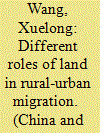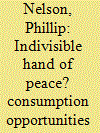| Srl | Item |
| 1 |
ID:
119154


|
|
|
|
|
| Publication |
2013.
|
| Summary/Abstract |
This paper explores the influence of land holding on rural-urban migration using China's 2008 household survey data. It shows that the contradictory findings of existing published literature can be explained by introducing a migration distance variable. The empirical studies show that land holding plays a different role in short-distance and long-distance migration. Land holding has a U-shaped curve association with the probability of short-distance migration and has an inverted-U-shaped association with the probability of long-distance migration. Therefore, the government needs to provide more job information and migration subsidies to farmers who have little land to overcome difficulties in the process of migration so as to reduce rural-urban inequality.
|
|
|
|
|
|
|
|
|
|
|
|
|
|
|
|
| 2 |
ID:
179956


|
|
|
|
|
| Summary/Abstract |
GDP is one of the most robust indicators of civil war onset. As debate continues over the mechanisms underlying the relationship between economic development and civil war, this paper scrutinizes the indicator of GDP directly, disaggregating it into its constituent components to examine whether their distinct associations with conflict onset can shed some light into the black box. Analysis of the individual correlations allows for identification of the driving force behind the aggregate statistical relationship. With this information to hand, consistency checks can be made with existing theories and a new theory presented in this paper, which draws attention to a critical structural factor that drives the supply of civil war labor, namely the lack of consumption opportunities. This factor increases the likelihood of civil war in less economically developed countries as individuals with low consumption opportunities have little to lose from reordering the economic and political system. Analysis of the correlations between components of GDP and the onset of civil war shows that this new theory is most consistent with the key drivers of the aggregate relationship. The examination also highlights a new indicator, which is arguably preferable to GDP as a measure of this relationship.
|
|
|
|
|
|
|
|
|
|
|
|
|
|
|
|
| 3 |
ID:
120395


|
|
|
|
|
| Publication |
2013.
|
| Summary/Abstract |
The aim of this article is to explore the defense-growth relationship in France. In particular, in the context of the crisis, we would like to compare the effects of military and nonmilitary spending on growth. Our results reveal that this is a complex relationship with a bidirectional causality. In the long run, defense expenditure exerts a positive influence and outperforms the impact of nondefense expenditure. However, an opportunity cost arises in the short run.
|
|
|
|
|
|
|
|
|
|
|
|
|
|
|
|
| 4 |
ID:
164524


|
|
|
|
|
| Summary/Abstract |
The Swiss Armed Forces are suffering from a structural deficit of militia officers despite good pay and a general supportive attitude in the population. Whereas, prior studies have focused on motivation to explain understaffing in armed forces, we offer an alternative approach based on opportunity cost. We model decision alternatives both within and outside a military organization, taking private sector employment as the reference point. We then monetize opportunity costs of leisure, fringe benefits, and private sector income not compensated. Our results suggest that in terms of opportunity cost, service as a militia officer is the least attractive option, an effect that we believe explains the persistent staff deficit. Implications of these findings for the literature and recruitment policy are discussed.
|
|
|
|
|
|
|
|
|
|
|
|
|
|
|
|